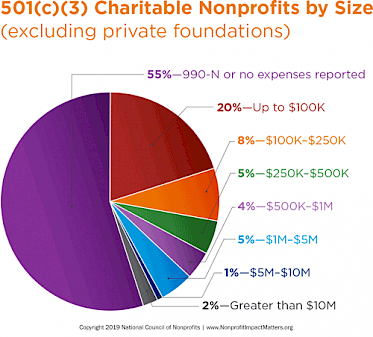What Can A 501c3 Do With Its Money
While nonprofits are all effectually us, in that location are common misconceptions about what nonprofits are and what they practice.
Myth: Nonprofits tin can't earn a profit
Reality: The term "nonprofit" is a bit of a misnomer. Nonprofits can brand a profit (and should try to have some level of positive revenue to build a reserve fund to ensure sustainability.) The fundamental divergence between nonprofits and for-profits is that a nonprofit organization cannot distribute its profits to any private individual (although nonprofits may pay reasonable compensation to those providing services). This prohibition against "private benefit" is because tax-exempt charitable nonprofits are formed to benefit the public, non individual interests. For more data, encounter this IRS guidance. Learn about what charitable nonprofits need to do to maintain their tax-exempt status.
Myth: A well-run nonprofit should have low "overhead" costs
Reality: Operating costs, such as paying utility bills, hire, salaries, and investing in office equipment are referred to past a variety of names, including "overhead," "administrative costs," and "indirect costs." While the terminology varies, one thing does not: these costs are essential to delivering on a nonprofit's mission, and have no relation to the level of effectiveness or the outcomes a charitable nonprofit may deliver.
Nonprofits are encouraged to join our campaign to "#OwnYourOwnCosts" and help to brainwash funders and donors nigh the true costs of delivering services. If your nonprofit requires college overhead costs to deliver services, show your supporters how those core infrastructure costs are essential and advancing your mission.
Myth: Nonprofits don't take paid staff; they only utilize volunteers
Reality: According to the Johns Hopkins Eye for Civil Society Studies and data from the Bureau of Labor Statistics, in 2016, nonprofits employed 12.3 million people - that's 10 per centum of private employment in the United States!
Myth: Nonprofits tin't lobby
Reality: Every charitable nonprofit tin can and should brand its voice heard on issues that are important to its mission and to the people or crusade the nonprofit serves. Equally advocates, nonprofits are sometimes required to speak up about policies, laws, and regulations; lobbying by nonprofits is permitted by law. However, tax-exempt charitable nonprofit organizations are NOT permitted to appoint in partisan political action, such as supporting or opposing any candidate for public office. For more than information on lobbying, see our advocacy resources.
Myth: Nonprofits get nigh of their funding from foundations
Reality: Foundation grants represent only a small role of the total amount of dollars contributed each year to the charitable nonprofit customs. Private philanthropy, which includes both donations and bequests from individuals and grants from private and corporate foundations, represents only fourteen% of the total annual revenue to the charitable nonprofit community, and of that, the majority is from contributions from individuals.

Myth: Charitable giving incentives but benefit wealthy individuals and aristocracy institutions
Reality: All charitable nonprofits do good from public support and donations, and most depend on private donations to serve their communities. While an individual taxpayer only receives a partial tax do good for charitable donations, the community served by the charitable nonprofit receives the full value of every dollar. Any cap on giving incentives negatively affect the community. For more information run across our resources on charitable giving incentives.
Myth: Nearly nonprofits are large and accept many resources
Reality: In fact, most nonprofits are minor in both budget size and numbers of employees. While large, well known nonprofits, such as the Reddish Cantankerous, accept high visibility, those nonprofits are actually non representative of the charitable nonprofit community equally a whole. 92 per centum of all reporting public charities had annual revenue of under one million dollars.

Source: https://www.councilofnonprofits.org/myths-about-nonprofits
Posted by: hixthavite.blogspot.com

0 Response to "What Can A 501c3 Do With Its Money"
Post a Comment